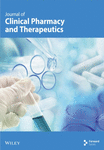Determination of heparin in aqueous solutions
Abstract
Objective: To develop a volumetric method for assaying heparin in aqueous media. Method: Heparin is precipitated out with an aqueous solution of an organic amine by titration and the end-point is based on the measurement of the medium dielectric permittivity. We studied the titration of a 500 IU/ml heparin solution with a 0·08 M cetylpyridinium chloride solution at pH 6·8. Then, we assayed sulphate groups selectively at pH 2. The results were compared against a classical method of SO 2 determination. The sensitivity and reproducibility of the volumetric method were evaluated at pH 6·8 and compared with the characteristics of a chromogenic method, usually used for the assay of heparin in biological fluids. Results: A linear relationship between anticoagulant activity and sulphate and carboxyl group concentration was observed. The method was less sensitive but more reproducible than the chromogenic method. Conclusion: The proposed method can be used for aqueous solutions and is easy to carry out. It can be fully automated and applied to formulation studies.




